#Hymns and Hieroglyphs
Explore tagged Tumblr posts
Text
You drive me crazy
I drive Miss Daisy
Before I take you anywhere
If I could get your smell out of my hair
You bum me out
I have my doubts
I sleep with one eye open
A toast and here's to hoping
That she'll clutch your pearls so hard that one popped off
He grinded his teeth 'til they were soft
Parking meters and laundromats ate my coins
(They ate my coins, what will I do?)
So I can't make a wish in a well, oh well
I'll sit back might as well enjoy
(I'll sit back might as well enjoy)
The part where Jack and Jill fell
They fell
You take me on
I should be gone
The doctor told me so
The doctor from that talk show
You make me wait
I hesitate
I'll pile up my books
And change my whole outlook
He drove his car right off the cliff
She wrote 'fuck you' in hieroglyphs (Fuck you, man!)
Parking meters and laundromats ate my coins
(They ate my coins, what will I do?)
So I can't make a wish in a well, oh well
I'll sit back might as well enjoy
(I'll sit back might as well enjoy)
The part where Jack and Jill fell
They fell
Jack and Jill went up the Hollywood hills
Winding canyon roads
No turning back
An earthquake shook the city of angels
And Jack and Jill fell right through the cracks
#The Tenth#The Tenth Dunes#Dunes#2019#Pop Punk#Punk#Bubblegum Punk#Taylor Blackwell#Harley Quinn-Smith#Harley Quinn Smith#Eden Hain#Kelly Cruz#Hymns and Hieroglyphs#Hymns & Hieroglyphs#The Tenth Hymns and Hieroglyphs#The 10th Hymns and Hieroglyphs#The Tenth Hymns & Hieroglyphs#The 10th#Spotify
1 note
·
View note
Text
// Hymn to Ra ~ ☀💛
𓁨𓅓𓆳𓏏𓏥𓅓𓊪𓏏𓇯𓅱𓃀𓈖𓇶𓂋𓂝𓇳I𓀭𓇋𓏏𓈖𓇳𓐝𓈌𓎛𓇳𓎛𓆖𓉐𓂋𓂻 𓆑𓅓𓄡𓏏𓏤𓏌𓏏𓇯𓁐𓏌𓏌𓏌𓇯𓈗𓏏𓆇𓁐 𓇳𓇰𓎟 𓌞𓋴𓂻𓇋𓂝𓎛𓇹𓇓𓅱 𓅓𓁷𓂋𓏭𓇯𓈖𓂧𓃀𓏏𓈅𓅓𓄫𓄣𓏤 𓄔𓅓𓏏𓆑𓏶𓅓𓁷𓂋𓏏𓇯𓂋𓍿𓏏𓀀𓁐𓏥 𓏎𓈖𓆑𓃀𓇋𓈗𓏥 𓉔𓇋𓇋𓀁 𓂻𓅱𓈖 𓇓𓏏𓉔𓂋𓅱𓇳𓏥 𓄔𓅓 𓌃𓂧𓅱𓀁𓈖𓎡𓊹I 𓆓𓌃𓋔𓇳I𓀭 𓈖𓂢𓇋𓇋𓀉𓇋𓅓𓊿𓏏𓈉𓄤𓏏, 𓅱𓃀𓈖𓇶𓇋𓅓𓉗𓏏𓉐𓃀𓈖𓃀𓈖𓉐 𓃹𓈖𓉿𓇋𓁹𓁹𓇋𓉐𓂋𓂻𓂝𓈖𓈋𓅱𓇶𓃹𓈖𓉿𓇋𓂋𓇋𓂋𓂻𓏤𓎛𓅱𓄑𓅆 𓂻𓅱𓄟𓋴𓏪𓇋𓏙𓈖𓈖𓍿𓈖𓏥𓋹𓎛𓇳𓎛 𓁹𓊨𓏏𓉐𓍿𓈖𓏥𓄜𓏏𓇶𓏥𓇋𓁷𓏤 𓊪𓋴𓆓𓇶𓏇𓇋𓏏𓈖𓇳 𓍿𓈖𓏥𓏏𓆑𓂧𓏭𓈐 Millions of years in the sky, Ra, the Aten, rises in the horizon for eternity He comes forth from the womb of Nut-Naunet every day and night The moon follows him above the Earth with joy The father who is in heaven, he hears the people and brings the floods Rejoice, the king of days has come. Listen, the god speaks to you Words spoken by Ra: I come to rest in the beautiful west, and I rise from the temple of the Benben I open my eyes and light comes forth, I open my mouth and Hu comes forth Come, my children, (I) have given you life for eternity Make your seat under my rays, shining like the sun Your father is here ☀---------------------------------------------- - Kemetnefret (Really enjoyed writing this and definitely the longest text I've written! Dua Ra!)
#kemetic#ancient egypt#kemetism#netjeru#paganism#deity work#deity worship#kemetic paganism#kemetisim#kemeticism#polytheism#kemetic polytheism#devotional art#witchblr#egyptian gods#ra god#re god#re#sun gods#hymn#poetry#hieroglyphics#hieroglyphs#ancient languages#language stuff#languages
96 notes
·
View notes
Text
a carrot prescription for a carat🥕
OT13 x 2nd pov
genre(s): fluff, humour
warning(s): none
word count: ~3.5k
*work of fiction that is what I think of seventeen and their ideal type, do not get any wrong ideas or judgement*
work all mine, no reposting without creds, no stealing of published work, copyrighted:D
scoups:
you huff, crossing your arms akimbo, sitting down neatly on the cold, hard floor as you turn away from him, pouting. "aww, are you angry at me baby?" his melodic voice makes your heart skip a beat immediately but you pretend you can't hear him and sulk even more. he scoots closer to you, wrapping his arms around you in a bear hug, and places your glasses back nicely resting on the top of your ears. "hey it's not my fault i asked you what you wanna eat but you couldn't see the menu from all the way over here." he chuckles, but you glare at him, "cheol who asked you to steal my glasses? tsk!" he smiles widely, shutting you up by leaning to press a soft kiss on your lips and you kiss him back. "chicken pho with extra noodles, right?" he breathes, nuzzling the back of your neck with his chin. you nod, as he continues, "still mad at me?" you nudge his shoulders nodding your head rather aggressively, but ultimately you end up crawling into his embrace anyway. "oh and i forgot, i'll add extra carrots too." you smack his arm, whining. he knows how much you hate vegetables so he must have a death wish. he flicks your forehead and giggles, running away, his voice trailing behind me, "carrots are good for your eyesight!" "YA CHOI SEUNGCHEOL-YOU'RE SLEEPING ON THE COUCH TONIGHT!"
jeonghan:
"hey y/n..." the cheekiness in your boyfriend's voice tells you he's up to something again. you close your book and turn to him, only to see him carrying a basket full of...freshly harvested carrots??? "first of all, how? and second, just, why hannie, why?" you smack your forehead but to your shock, he simply steps up to you and hands you one of the many carrots, and gives you a wink before walking off. you can still see dirt hanging onto the ends of the carrot you're now holding and you shriek, running after jeonghan. "yoon jeonghan, explain, now, 5,4,3-" you place your hands at the hips, narrowing your eyes. "honey, remember that other day you said you needed me to read the receipt price because you couldn't read it due to how small the font was?" you gulped. "where are you going with this?" you ask, cautious. he smiles again, it's even wider this time and he laughs, "babe, carrots will improve your eyesight! isn't this good? you can finally look at the receipt in the future and i don't have to pay all the time!" you grab him by the ear as he yelps in pain, starting a game of chase and tag right in the middle of your lawn.
joshua:
you didn’t even realise until he gently pointed it out: you were reading the bible upside down. “y/n baby,” he said, trying to suppress a laugh as he tilted the book the right way, “I don’t think the commandments mentioned decoding hieroglyphs.” then he handed you a sticky note that read, “thou shalt not mistake the couch for thy boyfriend,” and winked. embarrassed, you call him cute and giggle, make him wrap his arms around your waist, rocking you from side to side. from that day on, he began casually tagging everything in the apartment with lovingly hand-lettered, mildly biblical phrases: “let there be toothpaste, not moisturiser.” “this is not your charger. it is mine. sayeth joshua.” when you told him you flirted with a mannequin at the mall thinking it was him, he clutched his chest like you’d stabbed him with a hymn. later that night, he handed you a carrot wrapped in twine like a holy relic. “blessed be the seeing snack,” he whispered dramatically. “may it guide your path and not be confused with a toothbrush.” you think his antics are adorable, and you heartedly play along, pretending to bite the carrot even though the whole world knows you detest them because how could you let him down on his little skit?
jun:
he looked up from his phone just in time to see you confidently wave at a stranger’s car and try to open the passenger door. the stranger looked alarmed. jun looked traumatised. “do I look like a honda civic to you?” he deadpanned as he appeared beside you like a disappointed ghost. when you squeaked an apology and hid behind him, he just smirked and said, “we’re going to fix this—with science.” that night, he appeared in the living room in a white lab coat, holding a glitter-covered carrot and a homemade graph made out of cucumbers and googly eyes. “welcome,” he announced, his chinese accent making it ten times funnier, “to the future of vision: carrotvision™.” he played a fake ad using a projector and elevator music while narrating in a soothing voice: “one bite, and your sight increases by a scientifically unverified 0.2%.” you almost cried from laughing as he fed you the carrot like a sommelier. “results may vary,” he added. “side effects include kissing your actual boyfriend instead of traffic cones.” “youre so down bad for me!” you chuckle, as jun simply cuddles you harder, not saying a word an yet, his lips cheekily find their way to yours.
hoshi:
you called hoshi’s beloved tiger plushie “your orange boyfriend” one morning while trying to cuddle it, and he paused mid-chew of his toast. he slowly looked over, mouth full, and whispered, “you replaced me… with a stuffed animal?” he then collapsed very much overdramatically onto the floor like you’d committed a betrayal worthy of a soap opera and you slap your forehead. here we go again. “so this is how I go,” he said faintly. “defeated by polyester.” later that day, he built a ridiculous training course in the living room, complete with plushie decoys, orange hoodies, and tiger-print blankets. “mission: fine the real hoshi,” he said, pointing dramatically to a carrot trophy labeled TRUE LOVE. you grin at the sight, confidently stating, “fine hosh, game on.” famous last words. you tripped, hugged a chair, and mistook a pillow for him—twice. he finally jumped out from behind the couch wearing a cape made of towels, holding the carrot like excalibur(on behalf of his friend dokyeom).“you found me!” he cried. “and for your efforts, I present… the golden carrot of clarity.” you chuckled, giving him a smile, before chucking his favourite tiger soft toy at him and he gasps, “how could you do that?” you raise an eyebrow, “I thought you said I replaced him you with him, but im with you so I don’t need him.” he looks shocked, and you throw yet another soft toy, and sooner than the both of you realise, it turns into a whole out pillow soft toy fight—right in the middle of your apartments living room.
wonwoo:
he didn’t say anything when you confidently read your book upside down. he just sat across from you, a steaming mug of tea in hand, expression unreadable behind those familiar round glasses that always seemed to know more than he let on. after a solid twenty minutes, he tilted his head slightly and asked, “is that… how the story goes?” you blinked, realising that the characters had been, in fact, falling upward the whole time. he chuckled softly—not mocking, just warm—and got up to join you, flipping the book around before settling beside you, your shoulder tucked gently beneath his. “I didn’t want to interrupt your... adventure,” he teased, his voice low and laced with that subtle mirth only you knew how to decode. you smile at him, “why don’t we go on an adventure together?” he hummed, and peppered you with kisses, as the two of you fall in comfortable silence. that day, he handed you a handcrafted carrot-shaped bookmark. to help you stay grounded in this cruel, blurry world,” he said dramatically, then softened. “I made it for you. so you won’t have to squint so hard to find your place.” that night, he started reading aloud to you from the same book—page turned the right way up this time—his voice a quiet rhythm, steady and safe. between paragraphs, he pressed kisses to your temple and whispered, “you don’t need perfect vision. just someone who sees you clearly. I’ve got that part covered.”
woozi:
you thought the silence was safe until you loudly complained, “ugh, why does this toothpaste taste like lotion?” from across the apartment, woozi froze mid-note. slowly, almost ominously, he turned around in his chair with the kind of stare that could silence entire crowds. “…you did not,” he muttered, voice already laced with that dangerous combination of disbelief and resignation. you held up the tube innocently. “It was minty!” you defended, as he rubs his temple, already making his way over to you. ge snatched the tube, read the label aloud—hydrating hand cream with eucalyptus extract—then pinched the bridge of his nose like he was trying to physically hold his sanity in place. “why are you like this?” he groaned, heading toward the supply drawer. you whined, tugging his arm as he sighs, turning around and pulling you in for. a kiss. he could never really be mad at you, and you knew that, and you were using this to your advantage. the next morning, you woke up to a new system: every bottle, tube, container, and spray in your home was labeled like a preschool science fair. TOOTHPASTE = YES. HAND CREAM = NO. THIS IS SHAMPOO. STOP DRINKING IT. he even laminated the signs. but the best part? he handed you a bright orange carrot and taped a tiny microphone to it. “this,” he said with the deadpan precision only him woozi himself could deliver, “is your mistake announcement device, or, MAD. if you are about to confuse sunscreen with whipped cream again, you will report it to me first.” then, despite himself, he cracked a small smile, ruffled your hair, and muttered, “good thing you’re cute when you’re blind.”
dokyeom:
you once waltzed into the hallway, wrapped your arms around a floor lamp, and whispered, “you smell amazing today.” that would’ve been fine if your boyfriend dokyeom hadn’t turned the corner right then, arms full of laundry, watching you flirt with household furniture like it was completely normal. he gasped like a scandalized victorian woman. “AM I A LAMP TO YOU?!” you froze, mid-hug. “uhhh…no?” you chuckle nervously, hurriedly unwrapping yourself and running far far away from the lamp you were once having serious intimacy with and instead right into his arms. the silence was deafening. then came the dramatic collapse—he fell to his knees, clutching his chest. “is it because I’m tall? bright? electric?” he sniffled dramatically while you tried not to die of embarrassment. but the next day, he turned your shame into a full-blown musical event. he set up a fake stage in the living room, complete with a spotlight (a literal flashlight duct-taped to a broom) and performed an original ballad titled you light up my life, but mistook me for a lamp. there were carrot-shaped maracas. there were interpretive hand movements. at the climax, he handed you a bouquet made entirely of glow sticks and baby carrots. “for the only person who could mistake true love for furniture,” he whispered, holding your hand like he was proposing. you couldn’t even respond, you were laughing too hard. and then that night, he tucked you in, turned off the real lamp, and murmured, “you don’t need perfect vision to recognise me. just follow the voice.”
mingyu:
you squinted at your coffee, took a sip, and immediately choked. “why is this so… salty?!” you cried. mingyu whipped around from the stove in full panic mode, snatched the cup from your hands, sniffed it—and groaned. “that’s soy sauce. you just drank soy sauce.” his expression was pure chaos, like his soul had left his body. “oh my god, do I need to call poison control? google? MY MOM?is this a lawsuit??” he proceeded to pour you three glasses of water, handed you a carrot “for neutralising,” and paced around the kitchen like a first-time dad in a hospital waiting room. “you’re gonna be okay,” he kept muttering, dabbing your forehead with a dish towel. and then—kim mingyu-style—he went into overprotective overdrive. the kitchen was suddenly a military-grade safety zone: soy sauce and cold brew had been stored on opposite ends of the earth (aka top and bottom shelves), every bottle had big bold labels in 48pt font, and he installed smart lights that turned red when you reached for anything potentially dangerous. “babe, I love you, but you’re a walking food hazard,” he said, handing you a sippy cup and carrot sticks. “from now on, I’ll taste-test everything. including air.” he made you an eye appointment the next morning, then spent the rest of the night cuddling you like you’d survived a disaster. “just blink twice if something looks weird,” he whispered. “or blink once and throw a carrot at me.” you don’t say anything and close your eyes, refusing to blink and even with your poor eyesight, you already see and know the exact sight of a pouting man you would open your eyes to.
the8:
you waved affectionately at a very sleek, very shiny streetlamp and said, “babe! you cut your hair!” minghao, several feet behind you, paused mid-step. “that… is a pole.” you turned, confused. he sighed. “the pole doesn’t have hair, sweetheart. I do.” “oh right, uhhh uhm, the sky is pretty today right? and look at this beautiful amazing spectacular sunrise hahaha…” your voice trails off as you skip ahead, your pace obviously going faster on purpose. he watches you go ahead, your small silhouette becoming even smaller and tinier and he chuckles, calling out after you, “babe, the sun is setting, not rising!” he runs after you as you stop in your tracks for a moment before walking even quicker, your face blushing from embarrassment. you pretend you don’t hear him, but the way your actions slowed told minghao everything he needed to know as he caught up to you. later that evening, he handed you a deck of cards. “we’re playing a game,” he said, with a perfectly unreadable face. each card had a picture: a cat, a rice cooker, a carrot, a mannequin, minghao with his signature unimpressed expression. the goal? match the item to the correct label. every time you guessed wrong, he raised one elegant eyebrow and sipped his tea. “interesting. you think this is me?” he asked, holding up the cat card. “do I purr now?” you had half your mind wanting to tell him he could purr for you, making HIM the one flustered, but you eventually gave up, face buried in your hands, mumbling a soft “damn it this sassy boy.” and he? he just smiled, leaned over, and pressed a kiss to your cheek. “it’s okay. at least you’ve never mistaken my attitude for anyone else’s.” that night, he gave you a charm bracelet—each charm representing something you’d confused before. a carrot. a lightbulb. a tiny hao figure. (where did he get THAT from?) “so if you’re ever unsure again,” he said softly, looping it around your wrist, “just check your heart. I’m always the one it jumps for.”
seungkwan:
it happened on a casual saturday. you were strolling down the aisle of your favorite supermarket, happily humming, when you saw someone in a pastel sweater and instinctively clung to his arm, whining, “mom, can we get the carrot-shaped cookies this time?” the problem? it wasn’t your mom. or your boyfriend. it was a very confused stranger who stammered, “uh, I don’t… bake?” before you could dissolve from sheer embarrassment, seungkwan rounded the corner and saw the entire scene. he paused, blinked once, and dramatically placed his hand over his heart like a K-drama lead. “did… did my baby just mistake another for her mother?” he let out a betrayed gasp, then marched over and proclaimed, “MOVE ASIDE, IMPOSTER. I raised this child with my own hands and carrot juice!” the poor man fled. you were bright red. seungkwan, of course, milked it for days. ge began referring to himself in third person. “mother seungkwan demands you eat your carrots.” he printed out a little ID card that said emergency contact: MOM, laminated it, and clipped it to your bag. at home, he created a snack drawer labeled for my baby’s eyes only and filled it with carrot gummies, eye supplements, and handwritten affirmations like “you may not see well, but I see you.” he even sewed a patch onto your favorite hoodie that said, in sparkly embroidery, property of boo. you wanted to dig a hole, and bury yourself deep, and possibly never crawl back out. and yet, amid all the silliness, you noticed the way he gently guided you down curbs, the way he always walked on the side closer to traffic, the way he paused during concerts to scan the crowd for you—even in a blur, he knew where you were. “you don’t have to see perfectly,” he whispered one night as you leaned on him, exhausted from laughing, “just look my way. I’ll always wave back.”
vernon:
you were walking through the park together, casually talking about nothing and everything, when you suddenly stopped in your tracks, stared at a nearby bush, and said, “wow, you look really chill today.” vernon turned, followed your gaze, and realised you had just addressed a plant. a very leafy, unmoving, entirely non-human plant. “that’s… not me,” he said slowly. you squinted, then turned back to him. “I knew that,” you lied. “I was just joking.” “sure,” he said, utterly unfazed. “should I be jealous of the shrub?” he looked almost impressed, like he’d just discovered a new species of endearing weirdness in you. you tried to explain yourself like you owed him some sort of explanation, rambling on and on when you realised he hadn’t said a word. you ask, “non, were you even listening?” he gulps, “in all honesty no, but it’s because I was too distracted by your beauty…your weirdness is what I love about you, come on, let’s get back home.” you basically wrap yourself around him and he drags you home, both your faces beaming with smiles. when you came back to the apartment, you discovered a full-on vision simulator thing(?) had taken over the living room. he’d taped googly eyes to plants, put sunglasses on coat racks, and played lo-fi beats over a bluetooth speaker hidden in a cactus. there were sticky notes everywhere—on the fridge (not vernon), on the mirror (this is your face), on the dog plushie (vernon 2.0). you burst out laughing. “this is your revenge?” you asked. he grinned, holding up a sharpie. “it’s a rebranding.” that night, he sat next to you on the couch, your head in his lap as he absentmindedly braided your hair with little carrot-shaped beads. “you know,” he murmured, his voice soft and unhurried, “I don’t really mind if you see the world a little blurry. it just means you’ll always look at things longer, softer… like how you looked at that bush.” you groaned. “drop the shrub story already.” but he just chuckled and kissed your forehead. “nah. it’s my favorite love triangle.”
dino:
it started when you pointed to a baby picture framed on the shelf, smiled fondly, and said, “aww, I was such a cute baby.” dino, stretching next to you, paused mid-lunge. “that’s… me.” you froze. “no way, really? but the chubby cheeks! the bowl cut!” he stood up slowly, like he was rising from the ashes of a personal attack. “excuse you,” he said, voice scandalised. “that bowl cut raised me. it made me who I am.” he stared at you, betrayal in his eyes. “I thought you loved me for me—not because you thought I was your toddler self reincarnated.” you sputtered, trying to explain, but he was already pacing like a boy on a mission. the next day, you walked into the practice room and were immediately greeted by chaos. there were cardboard cutouts of him in every corner—some dressed in stage outfits, others in baby clothes. one was literally a mop with sunglasses and a sticky note that read cool dino that you made a mental note was jsut a copy off pi cheolin. there were decoy voices coming from speakers saying things like “hey babe, it’s me, the real one!” and “do you like carrots?” You stared, horrified and amazed. “what is this?” you whispered. “this is the ultimate sight challenge,” he said, striking a pose. “fine the real me before I start moonwalking backwards into your heart.” you wanted to say no but who could reject an adorable dino so you flashed a determined look on your face and got ready. uh, let’s just say, your preparation and efforts weren’t worth it, or were they? you failed the first two rounds, dramatically hugging a clothes rack once. but in the final round, you ignored the noise, followed your gut, and walked straight up to the real dino—who hadn’t moved an inch. you poked his cheek gently. “this one’s mine,” you say boldly. he beamed, hugging you so tight you couldn’t breathe. at night, curled up beside you, he whispered, “you may mistake faces. you may confuse mop handles for boyfriends, which truthfully how? we listen we don’t judge though. but you’ll never get my heart wrong. that’s how I know it’s real.”
#seventeen#svt carat#svt x reader#svt au#new author#seventeen au#svt#author#seventeen fluff#svt ot13#svt fluff#seventeen humour#svt humor#seventeen x reader#asheyxash#kwanniverse
37 notes
·
View notes
Text
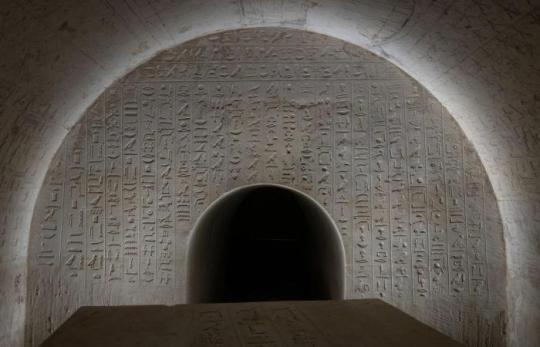
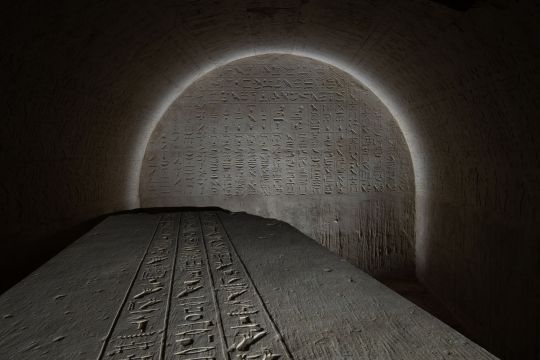
The Tomb of a Royal Scribe Discovered in Egypt
Czech experts have made another important discovery in the Egyptian archaeological site in Abusir. They found the hitherto unexplored tomb of the royal scribe Dzhehutiemhat, which is richly decorated in the form of many hieroglyphic texts and images. They mainly consist of ritual and religious texts, which were supposed to ensure the soul of the deceased an eternal life in the next world.
In April and May of this year, another part of field research by Czech Egyptologists regarding shaft tombs from the middle of the first millennium BC took place in Abusir, Egypt. It was here that the archaeological team of the Czech Institute of Egyptology of the Faculty of Arts of Charles University discovered the tomb of a hitherto unknown dignitary from the time of the Persian invasion of Egypt.
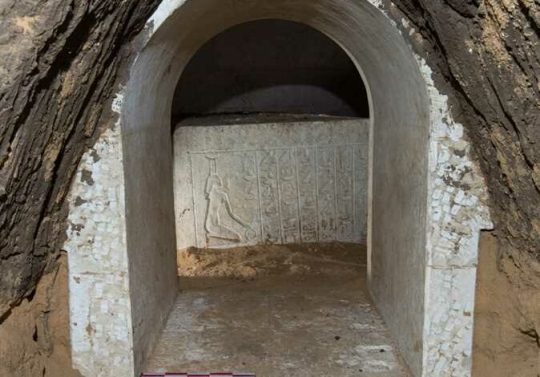

“It is a richly decorated shaft tomb of medium size, whose owner, a certain Džehutiemhat, held the office of royal scribe,” explains Ladislav Bareš, who has been coordinating the research of Abusir shaft tombs for a long time.
From the tomb, the above-ground part of which was destroyed already in ancient times, only the main shaft was preserved, at the bottom of which lay a burial chamber made of limestone blocks at a depth of 14 meters. Access to it was provided by a small, more northerly shaft and a narrow corridor approximately three meters long connecting the access shaft with the burial chamber.
For reasons still unknown, this access shaft was largely filled with several dozen decorated limestone blocks, originating from the dismantled above-ground part of the nearby majestic tomb of General Menechibnekon.
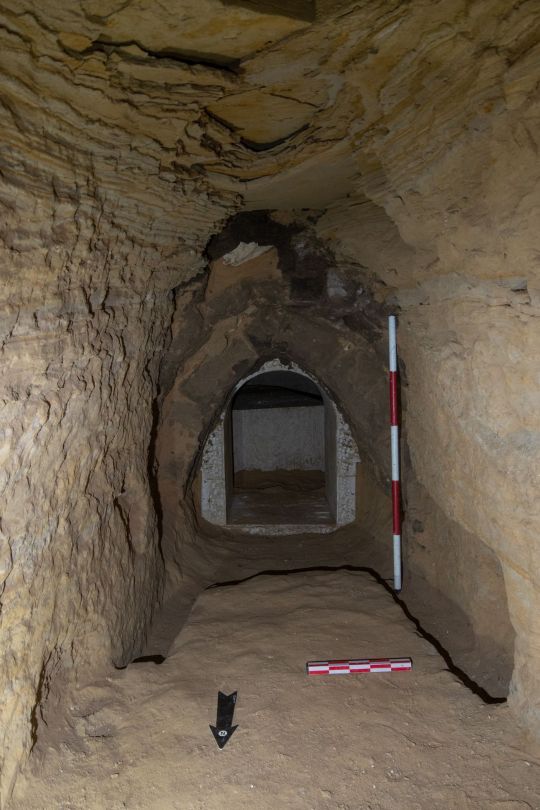
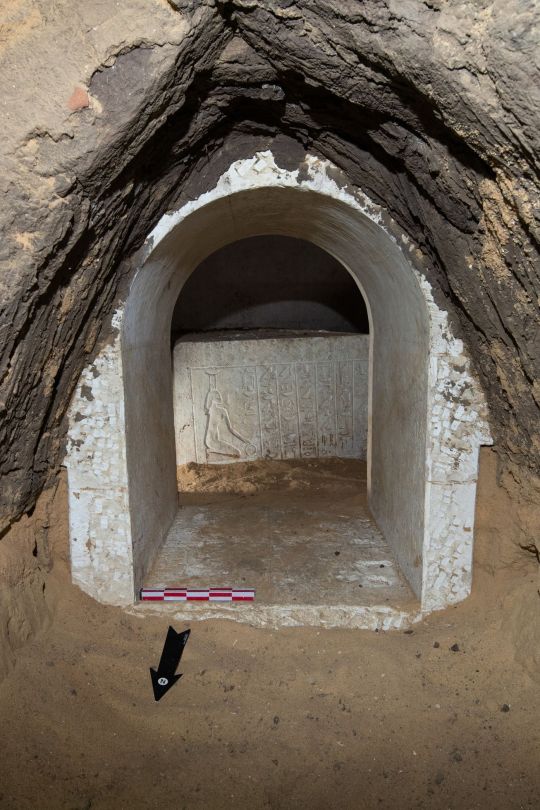
A tomb with rich decoration
The burial chamber is richly decorated with texts and other scenes. A long sequence of incantations against snakebite from the Pyramid Texts covers the north entrance wall. Interestingly, the snakes mentioned in these magical texts represented a potential danger, but could also serve as powerful protectors of the deceased and his mummy.
“While the entrance to the nearby Menechibnekon’s burial chamber was protected by the guardians of the gates of the 144th chapter of the Book of the Dead, in the case of Džehutiemhat, snakes from the Pyramid Texts play this role,” adds Renata Landgráfová, director of the Institute of Egyptology and an expert on the ancient Egyptian language and texts.
The south and west walls are covered with a sacrificial ritual and an extensive sacrificial list. On the ceiling of the burial chamber are depictions of the journey of the sun god Reo through the sky, first in the morning and then in the evening celestial bar. The depictions are accompanied by hymns to the rising and setting sun. Inside the burial chamber covered with relief decoration is a large stone sarcophagus, which also bears hieroglyphic inscriptions and depictions of gods, both outside and inside. The lid is decorated with texts taken from the Book of the Dead, but also excerpts from the much older Pyramid Texts, which partially repeat sayings that also appear on the walls of the burial chamber.
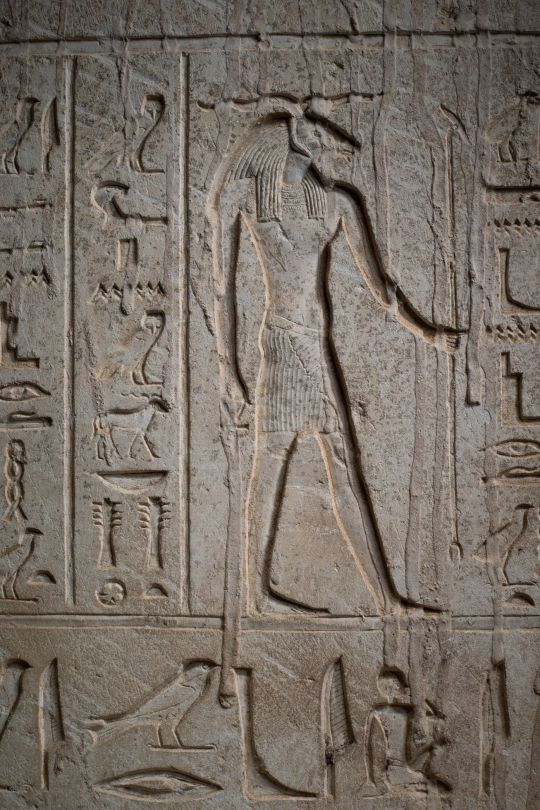
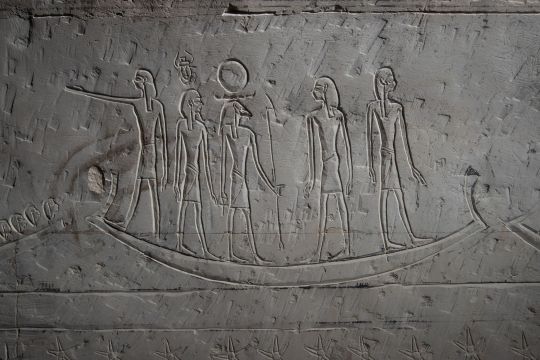
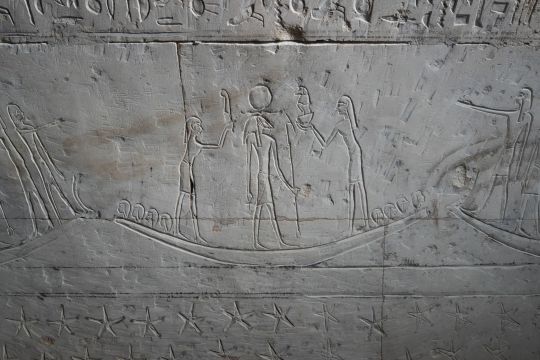
Ritual texts for eternal life
On the bottom of the inner wall of the sarcophagus bath, the goddess of the west, Imentet, is depicted, and its inner sides bear the so-called canopic sayings, spoken by this goddess and the earth god Geb. “The goddess of the west inside the sarcophagus represents the protector, guide and symbolic mother of the deceased,” explains Jiří Janák, who analyzes and interprets religious and magical texts as part of field research.
All the mentioned spiritual-ritual texts were supposed to ensure the deceased a smooth entry into a blissful and well-secured eternal life in the afterlife.
The tomb of the scribe Dzhehutiemhat was discovered almost empty, as it was robbed probably already in the 5th century AD, similar to other tombs in this burial ground.
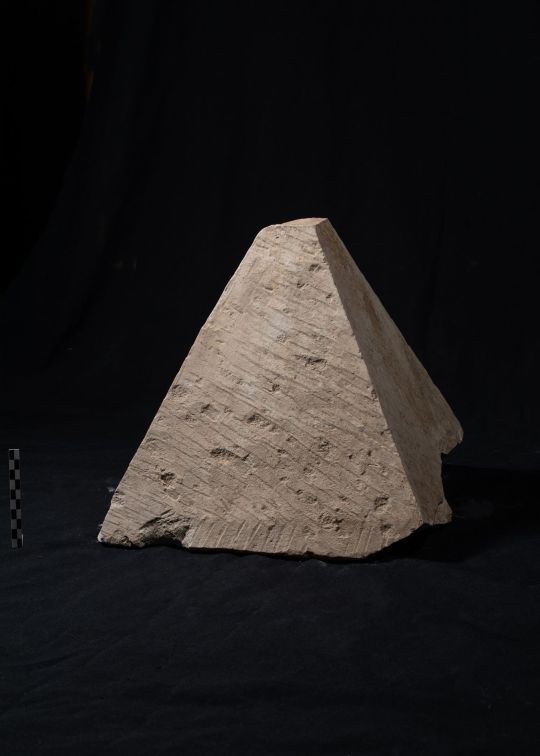


The deceased suffered from sedentary work
From the anthropological analysis of the skeletal remains, which was carried out by leading Egyptian experts, it was found that Dzhehutiemhat died at a relatively early age of around 25 years, he bore the signs of a kind of occupational disease (wear and tear of the spine during sedentary work) and suffered from severe osteoporosis, i.e. thinning of the bones.
The latter fact could place him in the family of other inhabitants of the Abusir shaft tomb burial, in whom the disease was also confirmed, such as the famous Iufaa, the owner of a nearby much larger tomb, whose unlooted burial chamber was discovered in 1996.
It is therefore possible that most of the owners of the tombs buried in this part of the Abusir necropolis belonged to one extended family, firmly anchored in the military elite of late Saiyan Egypt. However, Dzhehutiemhat’s mother probably came from completely different circles and a different part of Egypt at that time. Her two names can be translated as “Nubian” and “Fox”, while the latter is written in an unusual, most likely Berber form.
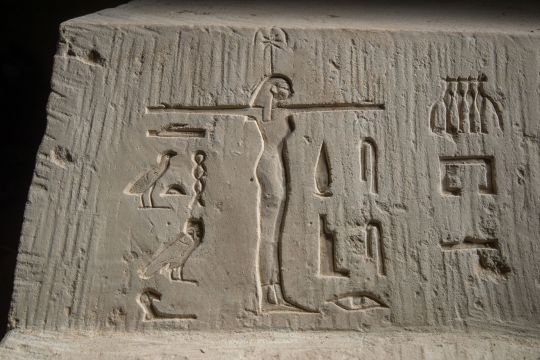
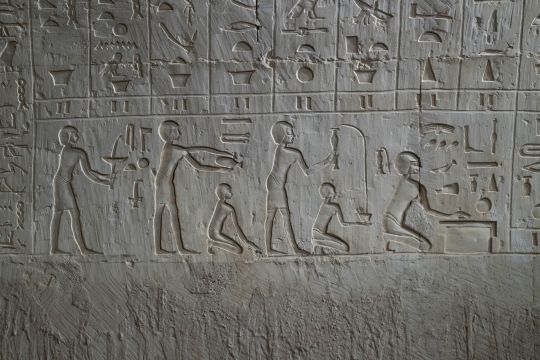
They also found a collection of pottery in the tomb. “The discovery of a large fragment of a Chian amphora with a perfectly smoothed edge is also very interesting, because the ancient looters probably used it as a shovel,” says Květa Smoláriková, who is an expert on Egyptian ceramics and Greek imports in the Czech team.
“The recently discovered tomb of the dignitary Džehutiemhat on the Abusír archaeological concession is the latest piece of knowledge in the mosaic of the history of ancient Egypt at the end of its glory in the late period, in the 6th century BC,” says Miroslav Bárta, director of Czech archaeological research in Abusír, about the discovery.
“The shaft tombs represent a special type of tombs of this time. They were created as a specific attempt by the ancient Egyptian elites for a renaissance and are based on the form of the tomb of King Djoser, the founder of the famous Old Kingdom, the time of the pyramid builders in the 3rd millennium BC,” he adds.
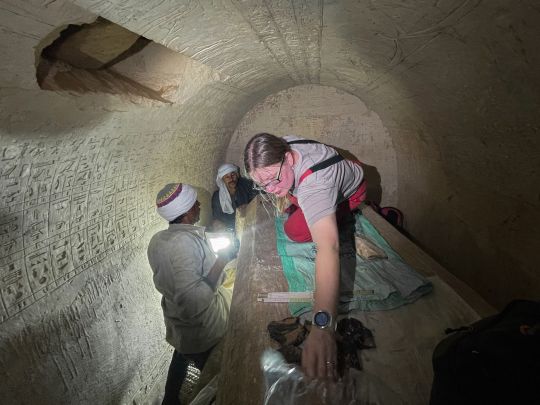

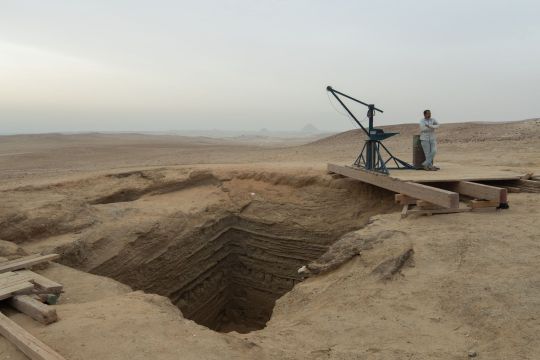
#The Tomb of a Royal Scribe Discovered in Egypt#Abusir Egypt#Dzhehutiemhat#first millennium BC#ancient tomb#ancient grave#ancient artifacts#burial chamber#Czech Institute of Egyptology#archeology#archeolgst#history#history news#ancient history#ancient culture#ancient civilizations#ancient egypt#egyptian history#egyptian art#long reads
428 notes
·
View notes
Text


"Splendid You rise in the lightland of the sky, O living Aten, creator of life ! You have dawned in the eastern lightland. You fill every land with your beauty." - Great Hymn to the Aten, 1-4.
Aten - Aton Talon Abraxas
Aten, also spelled Aton, is the ancient Egyptian deity associated with the sun and the sun's disk. The word "Aten" means "sun disk" in ancient Egyptian. In Egyptian mythology, Aten was initially considered to be a manifestation of the sun god Ra, who was one of the most important deities in the Egyptian pantheon.
23 notes
·
View notes
Text
Been doing some researchin'. Some explorin'. Been attempting in to narrow down the God-list and, in particular, sus out the Bishop's epithets.
Why would the Bishops have epithets? Well, all Gods have epithets for one. And Greek Gods especially have tons of epithets (and the game has given multiple nods to say it's pulling hard from Greek mythology).
For two, the "First Gods" and the "Great Ones" are two names that refer to the same group of deities, as was confirmed by Jojo. One phrase is their actual name (most likely First Gods, because that's how the bird trio exclusively refers to them) and the other is their epithet. They might both be referring to the same group, but one is going to inherently be more right than the other. See also: Narinder vs The One Who Waits.
The Old Faith are heretics, so I'm more inclined to believe "Great Ones" is the more ""wrong"" one. Isn't it interesting that the only time we see the two terms used interchangeably (in a visible way) is in the Ancient Tablets? The Bishops only ever use "Great Ones", but God Tears are exclusively documented as being tears from the "First Gods".
It's most likely reflective of the relationship between the names of Greek and Roman gods. They're technically different. Technically. Yet they're also the same enough that they can/could be used interchangeably. This even extends (to a lesser extent) to Egyptian and Norse Gods.
Not to mention, Leshy in of itself is an epithet. It's a phrase that means "from (or of) the forest". Other variants include "forest mother", "he", and "forest devil". [["He" vs "Me", how curious]]
It is... ~unlikely~ that there is only one case of something having two names. And if you happen to believe that "Old Gods" is also a term that refers to the First Gods/Great Ones, well then that's three names assigned to one group. So if they can have three, then the Bishops (and everyone else for that matter) can have two. [[Plus Hymns of the Unholy even calls attention to nicknames vs. true names.]]
...Moving on...
Leshy
Leshy is the epithet here, so it's actually more likely that one of the given names are secretly his rather than him having another title. Which makes this a bit harder lol. BUT.
Ala feels right. Emphasis on teeth and eating people, an association with the Underworld, and characterized by pride. Leshy acts pretty damn prideful. If he does have another Epithet he uses, I get the vibe it's the Fowler.
Though Leshy doesn't have a beak, some relics are just items that belonged to a God. Like the Seal of the Bishops or Clauneck's Shoe. But the Bones of the Fowler resemble the remains of worm enemies. And Leshy is our worm of note. If not The Fowler, then potentially The Starved.
Heket
I suspect Heket to be either The Icegore or The Widow, for similar reasons, funnily.
In my other analysis of Heket, I noted that she seemed to have an other-half that is no longer present. The Famine PMV also assigns "The Lovers" and "The Hearts" tarot cards to her. And her fourth most-listened to song suggests she was in an abusive relationship.
"Tears of loss, collected to rot."
"We fought, pathetic vessel. We bled. We grieved." "There is no justice in this world. No matter how... loudly you demand... urge... beg..."
Heket's words are often compared to the toxic mushrooms of Anura. Anura itself is a lowkey uninhabitable place because of the mushrooms. She was one who inspired fear through brutality, and fear is referenced to metaphorically as poison.
Heket's IRL counterpart is associated with fertility and reproduction—both in a human sense and agricultural sense. She was the wife of Khnum, a god responsible for creating new life. And her name is sometimes "spelled" with the hieroglyph for egg.
"Icegore" is likely two Old English words smashed together. "Ice", meaning "add, increase, endow, or impregnate" and "Gore" meaning "filth". And then there is the literal meaning in modern English: someone/something that gore's (read: pierces) with ice.
There's surely something about the Gem of Gore, a decoration associated with the Fanatic and the Old Faith. And the way that the freeze abilities operate very similarly to the Seal of the Bishops.
it's also interesting that the Scales of the Anchorite is coated in those rotten tears.
Kallamar
Kallamar isn't a name that means squid. Kallamar is squid. So I could make the argument that, like Leshy, he has a real name hidden somewhere as well as an epithet.
To start, he's surely the Necromancer. I mean, he literally summons the dead. The symbol for the "Coward" trait mimics the way ghosts are drawn. Divine Blight uses the same particle effects and animations as the ones used when Kallamar curses your Followers. But that's not an Epithet, that's a job title.
I initially suspected that he was The Slythor, something that would sit at the intersection of death and decay... something that's clearly associated with the Bane Weapons. Something that blights. Snakes are also heavily associated with medicine and health gods like Apollo and Asclepius. But I think this may be the epithet of the God implied to be accompanying Kallamar on some level.
Kallamar's epithet is most likely The Fervant, one of the Eyes of the Lost. Kallamar is one of "the Lost" after all, it's the quest header for killing the Bishops. "Hearts of the Lost". These eyes are referred to as Familiars in the files.
Eyes open still in supplication.
Supplication effectively means worship. Specifically to ask/pray for something in a humble fashion. Usually help.
The Eye of the Fervant is unique compared to the other eyes in various ways. For one, it's the only Familiar that doesn't make contact with enemies. (Kallamar requests that the Lamb not let anything hurt him when he's a demon, another kind of Crusade companion). The Coward trait also gives the unique thought, "Don't touch me."
For two, it's the only Familiar that manifests as only one eye. (Both Kallamar's statue and his Purged form make it seem like he should be missing an eye). For three, it gives the appearance that its pretending to be something it's not. The shroud/'mask' over it makes the eye appear as vibrant orange, but the holes in it reveal that the true colors are a pale pink (salmon kinda?) and yellow-orange.
The Pestilence Crown is dark blue. But Kallamar's crown is teal (more cyan when it's not glowing). The very fact that it flickers on and off like that during his boss fight is weird. There's something about his Crown. Maybe it's not real, maybe there's something wrong with it. But there's. Something. It's certainly not dark blue anymore.
And fourthly, it's kinda fucking useless.
Mimicking another God's power? That is just about what the Holy Hand Grenade is. That fire isn't being generated by him, it's generated by whoever blessed it. Hence the incantation he has to do to activate it. Plus the staff that summons, uh, jellyfish. Whereas everyone else summons their own species by just calling for them.
Plus the various implications and hints I've found that suggest that Kallamar, as a God, is inherently dependent on other Gods for power. Examples include the "Strength From Without" Tarot card being associated with him via the Pestilence PMV, "kala" being the Greek word for bine, a type of plant that depends on other plants and structures to grow, and even the fact that he has to be possessed to be made to fight the Lamb(lol).
I think that might make him Warracka's Slave, then.
Shamura
It seems most likely that Shamura* is The Anchorite. Primarily because of the Balm of the Anchorite, and the other details just sort of neatly fall into place.
Although they're all wounded, and they've all been cursed by Narinder(?) to never heal... have you ever noticed that the only one who ever actually complains of pain is Shamura?
"Ah... my head. You are the Lamb. I have need..." "...ah, the pain is... gone... the pain is gone. Ha..."
The Balm of the Anchorite is made of faith and rosemary. Rosemary is a plant commonly used in folk medicine to treat pain, muscle cramps, insomnia, hysteria, and depression. In witchcraft, it's used for healing, purification, and protection.
'Hysteria' is a blanket term that covered hallucinations to various levels of anxiety (or just being considered too emotional overall). Among Christian theologies, it was believed to be caused by sin and/or demonic possession. Shamura would absolutely be considered hysterical for a multitude of reasons.
The Anchorite's Relics demonstrate a strong association with and/or a reliance on Followers for their power. In a similar way to how Clauneck derives his power from Tarot Cards. ie, it's the Followers that have the power, it just can only be utilized by the Anchorite.
The Balm heals (using Spirit Hearts) and the Rosary Beads do damage. Their Blessed forms depend on the Elderly, and their Damned forms depend on Dissenters. Just to quickly run through some things of note from each description...
"Each bead whispers a name..." A 'bead' is a prayer, so each prayer whispers a name. That name is likely "mercy". [see: "Mercy is not my name."] The second/alternative meaning would be that each prayer (or the literal rosary beads) contains an insult. This could be playing into the 'madness' aspect of this, as Sozo, our baseline for madness, holds lots of paranoid thoughts about his Followers, including that they're speaking badly of him in secret. But the insults could be real. More on that further down.
"Wisdom Calcified." Literally, wisdom made inflexible. Which is, ya know, kind of an oxymoron. nudge, nudge. Secondary meaning elders (representative of wisdom) calcified, or even referring to their head injury, which could cause calcification of the brain. Something that causes movement difficulties, memory loss, difficulty concentrating, psychosis, and more.
"Those who would question, be strung." Which seems to be reference to skeptics/nonbelievers/dissenters either being punished or reeducated via substance use. There are also, notably, specially marked skeletons hanging (aka 'strung up') in Silk Cradle.
"They shall never leave us." Who 'they' is has two strong possibilities. It's either talking about Elderly Followers or a particular sect of elder deities. There are a handful of references to "Their" presence and worshipping "Them" in the sermon menus.
Both Elders and Dissenters prove to be more potent substances for healing.
And as an added layer, each Relic's lore text seems to be a nod to the circumstances surrounding that God's defeat. For the Bishops direct body parts, it was the whole see no/hear no/speak no/think no/do no evil thing.
There are no hints to suggest that Shamura was particularly disliked. They were feared, and towards the end of their life pitied, but never treated with disdain. Jojo suggests they were very respected, even.
But there is a God that is regularly insulted, by everyone, no matter their position in the hierarchy. Kallamar, the Coward. Perhaps the implication is that an aspect of Shamura's fall/defeat is due to Kallamar.
*It's 'not-Shamura' really. Various evidence suggests that Shamura is the intruder to this body, and thus wasn't always a spider.
Aaand, we've reach the end! I think this digs up a lot of much-needed context surrounding the Bishops. To summarize, we have:
Leshy the Fowler (or Ala, the Leshy) OR Leshy the Starved,
Heket the Widow OR Heket the Icegore,
Kallamar the Fervant,
and Shamura* the Anchorite.
#cult of the lamb#cotl theory#cotl#cotl shamura#cotl kallamar#cotl bishops#cotl heket#cotl leshy#long post#you can tell which ones ive researched more lmao#cult of the lamb shamura#cult of the lamb kallamar#cotl lore
22 notes
·
View notes
Text
ΑΒΡΑΣΑΞ -- ABRASAX From a Hermetic Viewpoint.

To the Gnostics, Abrasax is the great archon who created the whole world. There is quite a bit of nuance considering how Basilides Gnosticism views this deity. Nuance that I am not qualified to go over at the moment. Carl Jung refers to Abrasax as a truly terrible entity that encompasses all evil and all good, in his Red Book. I've seen negative reactions from people on Discord to this entity, but also some positive reactions.
But to the Hermeticist…who and what is this weird rooster head, snake-legged deity that is found all throughout the Greek Magical Papyri (PGM)? Let’s find out?
In the Discourse of the Ogdoad and Ennead (D89) we are given strings of vowels and nomina Barbara for the Hermetic student, namely Tat as he is being taught by Hermes. To Christian H. Bull in his The Tradition of Hermes Trismégistōs, the string of Greek vowels and nomina Barbara/voces magicae is the totality of the Kosmos. Tat asks to receive the imprint of fullness by ways of hymns of praise to God. Bull seems to agree with Alberto Camplani that the “imprint of Fullness (Pleorma)” is coded within these string of vowels and voces magicae.
From personal experiences — I have to agree with this, but I had to fuck around and find out for myself as I read this book many months ago when vowels and voces magicae were not big in my praxis. Anyways, here is the full hymn:
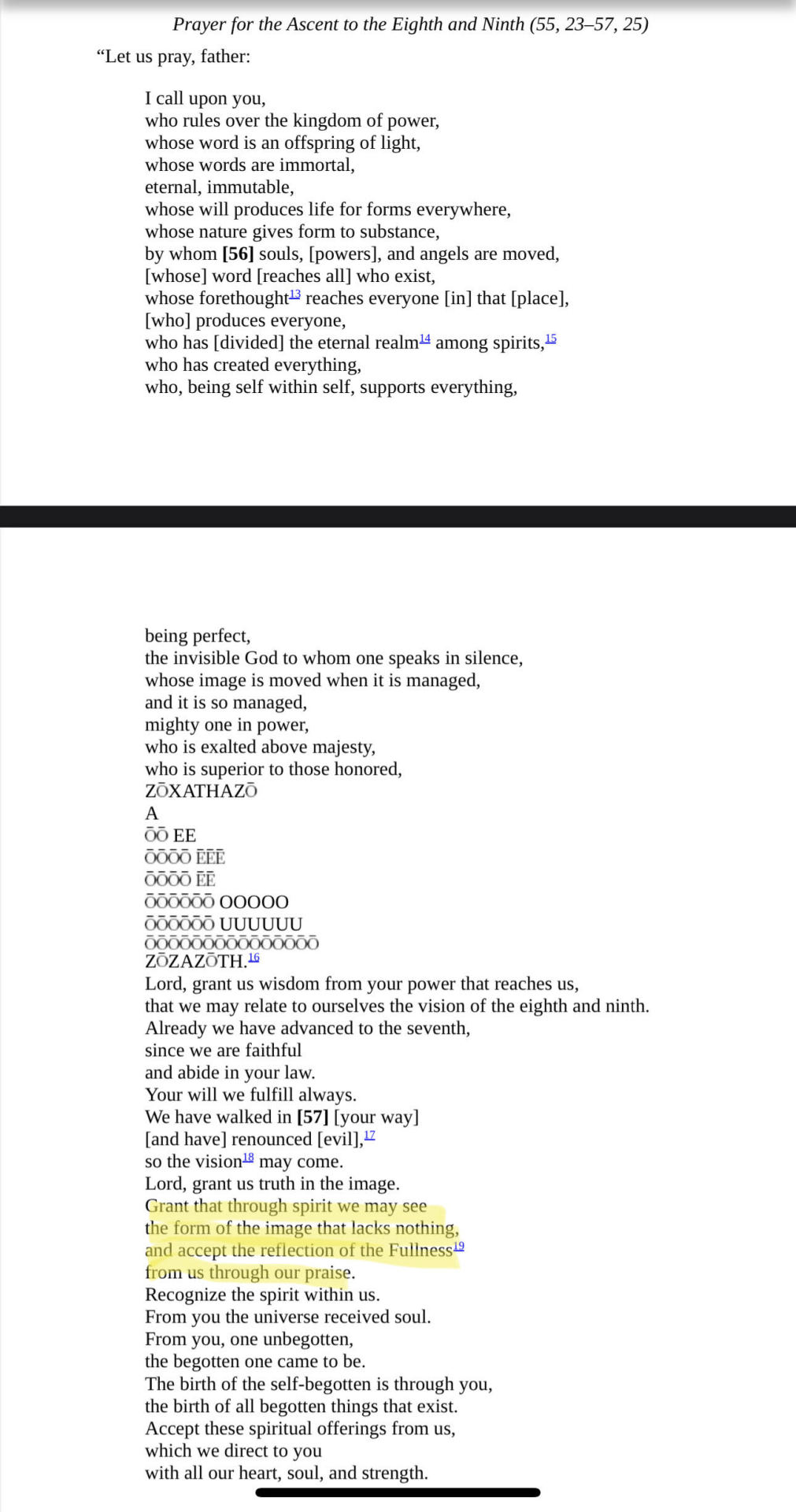
Great! So how does this tie into ΑΒΡΑΣΑΞ and what is this names value to a Hermeticist? For starters — This name, has a numerical value of 365, according to isopsephy. 365, as the majority of you know, is the totality of days our Earth revolves around the Sun. In PGM VIII. 1-63, specifically in lines 45-50… we see a love spell invoking Hermes to which we are given the name of ABRASAX equaling 365 explicitly, and quite possibly a voces magicae for Hermes.
The Sun's importance in Hermeticism is ever-present. Most explicit in my opinion is SH 2a from M. David Litwa’s Hermetica II:
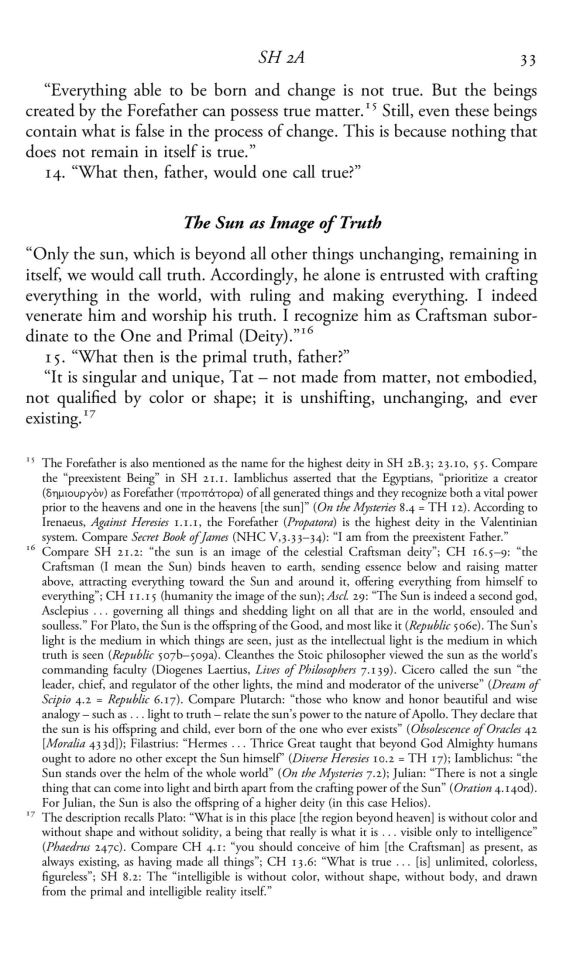
Also important to note: Thoth. Many believe Thoth is just the god of the Moon, yet Thoth has a Solar form: the Baboon. Baboons and their screeches are believed to be connected to the language of the gods. This is confirmed in the Demotic Book of Thoth. Where a scribe of Thoth’s Scribal College: The House of Life [𓉑], says this about the great teacher, Thoth: "The signs revealed their form. He called to them and they answered to him. He knew the form of speech of the baboons and the ibises." Thoth is also believed to be the creator of not just words and language but also vowels (Philebus 18b-c). For clarity's sake, Thoth is an extremely important figure in Hermeticism. Our teachings are based upon a syncretic god: Hermes & Thoth — Hermēs Trismégistōs.
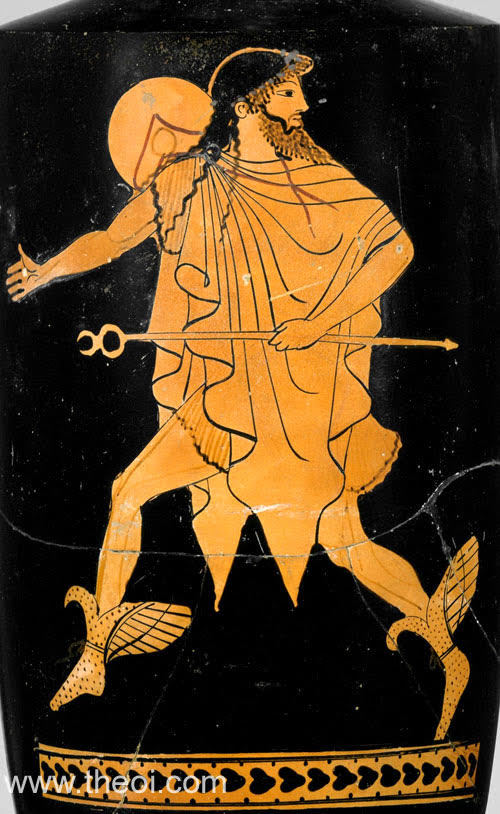
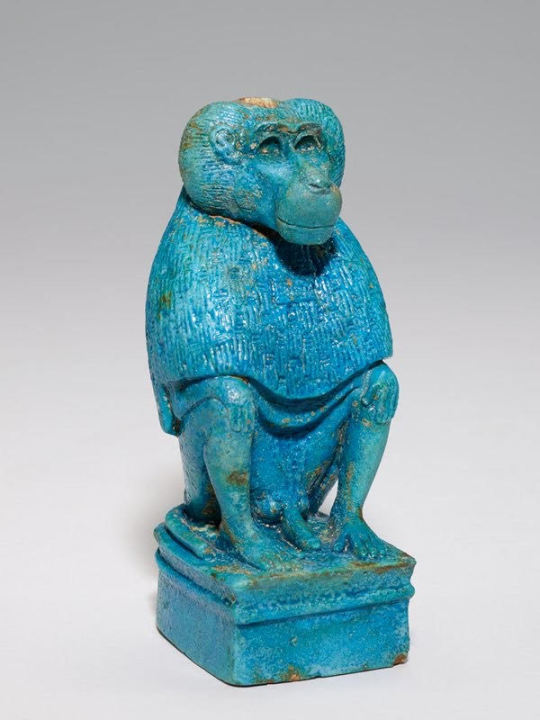
More evidence for the importance of ΑΒΡΑΣΑΞ is found in PGM XIII.1-343 — the famed Heptagram Rite, which we can perform more clearly and neatly here. This is a ritual that invokes Aiōn. Aiōn is believed to be the power of the Unknowable, Ineffable Godhead in Corpus Hermeticum XI. In lines 80-89 of PGM XIII, we are given voces magicae to Aiōn in 7 different languages as seen below.
Birdglyphic: ΑΡΑΙ Hieroglyphic: ΛΑΙΛΑΜ Hebraic: ΑΝΟΧ ΒΙΑΘΙΑΡΒΑΘ ΒΕΡΒΙΡ ΕΧΙΛΑΤΟΥΡ ΒΟΥΦΡΟΥΜΤΡΟΜ Egyptian: ΑΛΔΑΒΑΕΙΜ Finally, in Baboonic: ΑΒΡΑΣΑΞ
(The voces magicae for Aiōn is continued in 'Falconic' and lastly hieratic languages). Thus, we can see a clear link to baboons and Thoth, the name Abrasax to the baboons, and their "language." We see a connection between Aiōn and Abrasax, and we also saw above in PGM VIII that it could also be used as a voces magicae to Hermes!
But let’s look at the imagery as well. A rooster head with snake legs. The legs, to me, are Chthonic of course, and curl up to shape an Ω, the seventh sphere, Saturn. The connection to Omega is something Christian H. Bill points out. The rooster is also a Solar animal. So to me, we have a beautiful image representing the totality of All Things from the Sun whose an image of Truth, directly subordinate to the One Primal Deity (SH 2a), down to the Du’at/Underworld. Both Hermes and Thoth are connected to the Underworld as well as the Sun. Hermes' planet, Mercury is the closest planet to the Sun. Hermes is also famously known as a psychopomp, a traveler and mediator between Hades and Mount Olympus, Death and Life. Thoth, with His solar connections stated above, is also a key member of the Ancient Egyptian Underworld. In the Ani Papyrus, we see Thoth as the recorder/scribe that lists every heart that is weighed up against the Divine Feather of Truth -- Ma'at.

Thus what we have here, from a Hermetic standpoint, is that Abrasax is not a malevolent archon or a demon as denoted by the early Catholic Church, but rather a beautiful deity that is worthy of reverence whose name equals our revolution around the Sun, the Image of God. Abrasax — a name that is connected to both Hermes and Thoth, for reasons stated above. A name that also has a connection to Aiōn, an extremely important power/god in Corpus Hermeticum XI.
That is my interpretation, from a Hermetic standpoint. There are many interpretations of this elusive yet captivating deity. Abrasax can be a voces magicae for Hermes, or for Aiōn, it can be what I said, or you can take the Gnostic approach, or Jung, or Catholic approach to Abrasax. Regardless of what you do with the information, I shall continue to raise my voice in jubilation and cry out:
ΧΑΙΡΕ ΑΒΡΑΣΑΞ !
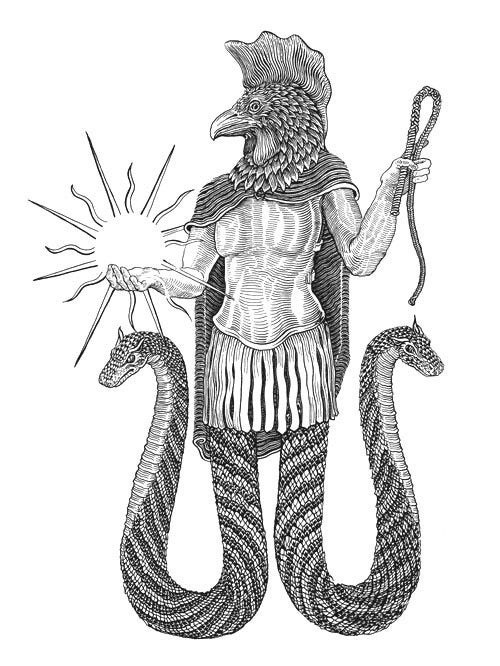
#hermeticism#gnosticism#demon#aion#greek magical papyri#corpus hermeticum#Ogdoad#ennead#nag hammadi library#Abrasax#archon#hermetica#magic#ritual#spells#hermes trismegistus#hermes#thoth#greco egyptian#egyptian#Greek#mythology#underworld#sun
46 notes
·
View notes
Text

The Jellyfish and the Dreamer
I drift—no spine, no anchor,
just a pulse of borrowed light,
a trembling lantern
suspended in the hush of liquid time.
Filaments whisper,
soft as a secret between waves,
ghost-limbs tracing hieroglyphs
upon the skin of the abyss.
I do not swim.
I am moved.
The sea inhales,
pulls me through phosphorescent corridors,
where moonlight shatters
into silver-veined infinities.
I wear the hush of the deep
like a second skin,
woven in tendrils of silk and sting.
Was I ever more than this?
A current’s captive, a dreamer’s reflection,
a thought without gravity,
a sigh made visible
in the cathedral of salt and silence.
Touch me,
and I will leave a burning memory
on the shore of your hand.
Let me go,
and I will dissolve into the language of the tide,
a ghost among ghosts,
adrift—
a pulse of borrowed light.
Veins of the Ocean
I have forgotten the weight of land,
the brittle arithmetic of footsteps,
the insistence of gravity pressing against my name.
Here, in the belly of the tide,
I am only a whisper of motion,
a vein in the ocean’s dreaming body.
The water does not ask where I came from.
It does not measure my worth
in syllables or skin.
It sways me between now and never,
a pulse of phosphorescence
in the throat of an unbroken hymn.
Somewhere, the shore is waiting,
but I do not belong to edges.
I belong to the hush between waves,
to the language of creatures
who speak in glow and silence.
If you must find me,
follow the shimmer—
I am the soft breath of light
woven into the dark,
a jellyfish untethered
from the hands of time.
16 notes
·
View notes
Text

Prayer to the Goddess Aset (Isis)
Praise to you, Isis, the Great One, The mother of Horus, Lady of Heaven, Mistress and Queen of the gods.
You are the First Royal Spouse of Osiris, The supreme overseer of the Golden Ones in the temples, The Eldest son, first born of Geb.
Praise to you, Isis, the Great One, The mother of Horus, Lady of Heaven, Mistress and Queen of the gods.
You are the First Royal Spouse of Osiris, The Bull, the Lion who overthrows all his enemies, The Lord and ruler of eternity.
Praise to you, Isis, the Great One, The mother of Horus, Lady of Heaven, Mistress and Queen of the gods.
You are the First Elect One of Osiris, The perfect youth who performs slaughter among the disaffected of the Two Lands.
Praise to you, Isis, the Great One, The mother of Horus, Lady of Heaven, Mistress and Queen of the gods.
You are the First Royal Spouse of Osiris, One who protects her brother and watches over the weary-of-heart.
Praise to you, Isis, the Great One, God’s mother, Lady of Heaven, Mistress and Queen of the gods.
You are the First Royal Spouse of Osiris, The Eternal One rejuvenating himself, who raised up Eternity: You are with him in the Temple (of Philae).
Praise to you, Isis, the Great One, God’s mother, Lady of Heaven, Mistress and Queen of the gods.
This hymn is inscribed in hieroglyphs on the rear wall of the temple of Isis at Philae – circa 300 BCE
We are gods in the body of god, truth and love our destinies. Go then and make of the world something beautiful, set up light in darkness.
Egyptian Book of the Dead, more correctly translated as the Book of Coming into the Light.
14 notes
·
View notes
Text
Clothing Rituals
This type of ritual was performed daily, monthly, for special occasions, or it was done annually for the New Year in Ancient Egypt- this largely depended on the temple and the time period. They have been attested dating back to the Old Kingdom and lasted until Ptolemaic times. From the Abusir papyrus that was found in royal funerary temples- specifically from pharaohs Neferirkare and Raneferef, we can see that these rituals were done monthly; however, the deity of the temple was the deceased king. In later times, this ritual was performed daily for the main gods in the temple. What we do know from this type of ritual is best explained in pBerlin 3014, pBerlin 3053 and pBerlin 3055 (which is dated to the 22nd dynasty), along with the temple of Seti I in Abydos and Ptolemaic temples.
In the morning, the ba was reawoken for the god by unveiling them from the night before. You would say your admiration of the god with a prayer or hymn before washing off the mD.t unguent and undressing it from the mnH.t cloth. The mD.t unguent and the mnH.t cloth is speculated to help with regeneration and renewal. The mnH.t cloth was commonly “depicted as one or two stripes of cloth folded in half and often referred to as four-coloured cloths- white, green, red and blue (or dark-red). Each of these colours had its own symbolic meaning connected with protection, health, fertility, regeneration and renewal” (The Clothing Rite, 66). Next, the statue was then purified with natron and incense (perhaps myrrh, frankincense, or palmonia resin) before it was redressed in clean mnH.t cloth. The mD.t unguent was reapplied to the statue, along with green and black paints. Next, formal clothing was adorned to the statue, along with jewelry and pectorals before, lastly, the final purification and fumigation took place.
How can you implement this into your practice?
Based off of the steps known from ancient practices in temples of Egypt, it is possible to do a daily rite with this, if you choose, or on days when you want to go to your own shrine.
First, find a place for your statues so they won’t get damaged. Find a good piece of cloth, preferably linen to conceal the statues when they’re not at the forefront of your practice. When they’re not in the forefront of your practice veil the statue.
Unveil the deity’s statue.
Next, invoke the deity along with saying or singing a prayer/hymn.
Third, use natron to help purify and light some incense. You could use something universal like myrrh and frankincense or your could use UPG and choose the one you think they would like best.
Fourth, dress the deity in some new cloth and annoint the statue. I cannot find anything about mD.t ungunet at this time but you could use something that you’ve dedicated to just them- whether you make your own oil or purchase it.
Fifth, add on the regelia and jewelry. While this step isn’t always possible for everybody, I will add it. You could get Barbie jewelry to add or you could make your own to size. You could repaint on the makeup if you choose, as well.
Lastly, the final purification and fumigation. Relight your incense. This one should be more specific to cleansing.
Sources:
Coppens, Filip. Vymazalová, Hana. “Linen for the God: The Interpretation of Old Kingdom Clothing Rites in the Light of First Millennium BC Rituals (and vice versa).” 2016. https://academia.edu/resource/work/37212908
Coppens, Filip. Vymazalová, Hana. “The Clothing Rite in the Royal Temples of Abusir.” 2009. https://www.researchgate.net/publication/291332482_The_clothing_rite_in_the_temples_of_Abusir
Sharpe, Samual. “The Rosetta Stone in Hieroglyphics and Greek Translations. 1807. https://www.ganino.com/anteanus/scripturam_aegyptium_rosetta_stone
#clothing rituals#ancient egypt#rituals#kemetic rituals#kemetic paganism#kemetic#kemetism#pagan#paganism#ancient kemet#Netjeru#ancient practices#modern day practices
59 notes
·
View notes
Text

About this eBook
TranslatorRenouf, P. Le Page (Peter Le Page), 1822-1897TranslatorNaville, Edouard, 1844-1926TitleThe Egyptian Book of the deadOriginal PublicationUnited Kingdom: Society of Biblical Archaeology,1904.NoteReading ease score: 80.9 (6th grade). Easy to read.CreditsRichard Tonsing, KD Weeks and the Online Distributed Proofreading Team at https://www.pgdp.net(This file was produced from images generously made available by The Internet Archive)Summary"The Egyptian Book of the Dead" by P. Le Page Renouf and Edouard Naville is a historical text and religious document compiled from various periods of ancient Egyptian civilization. Likely written from the Old to the Ptolemaic period, the work is a collection of spells, hymns, and prayers designed to guide the deceased through the afterlife, promising resurrection, eternal life, and the favor of the gods. The text reflects the Egyptians' profound beliefs in the afterlife and the importance of proper rites to ensure safe passage and enjoyment of eternity for the departed. The opening of the text introduces transcriptions and notes, indicating careful preservation of the original hieroglyphs and commentary on textual variations. The initial chapters outline essential themes such as resurrection and entry into the afterworld, culminating in the supplication of deities like Osiris and Thoth for assistance in navigating the challenges of the Netherworld. Each chapter serves as a guide for the deceased, providing powerful invocations and affirmations that highlight their identity as Osiris or favored by the gods, thus underscoring the belief in transformation and communion with divine powers in life after death. (This is an automatically generated summary.)LanguageEnglishLoC ClassPJ: Language and Literatures: Oriental languages and literaturesSubjectFuture lifeSubjectIncantations, EgyptianCategoryTextEBook-No.69566Release DateDec 17, 2022Most Recently UpdatedJan 17, 2023Copyright StatusPublic domain in the USA.Downloads3035 downloads in the last 30 days.Project Gutenberg eBooks are always free!
3 notes
·
View notes
Text
@yngwrthr I reproduce here your note under my answer to your initial ask (https://aboutanancientenquiry.tumblr.com/post/769881897370271744/hello-there-great-blog-as-always-thank-you-for ), because it is more convenient to reply to this note in the form of a post:
I am not sure that I 100% agree with the claim that Uzdavinys is guilty of exaggerating the continuity between Egypt and Greece. Have you read Jeremy Naydler’s “Shamanic Wisdom in the Pyramid Texts” or his “Temple of the Cosmos”? Approaching the problem from completely different angles, he arrives at identical conclusions independent of and much earlier than Uzdavinys, barely acknowledging the Greeks. Even the late J. Assmann, who went so far as to deny any presence of mysticism in ancient Egypt, attributed a “pre-theoretical Platonism” to its priests and scribes..
I have not claimed anything with certainty about Uzdavinys, as I have not read his book on Orphism. I have just expressed my doubts about the Perennialist school in which he belonged, doubts which don't lead me to reject totally the contributions of the members of this school (I made clear that some of them are eminent scholars). On the other hand, the truth is that I found after some search that Uzdavinys' book did not attract attention from the community of the scholars specialized or interested in Orphism and did not play any role in the debates of this community. But I repeat that all this does not mean that I see a priori his book as not valuable.
I have not read any of Naydler's books. I have searched a bit about him on the net and I found that he, too, is a Perennialist, like Uzdavinys. I have not found anything about him relevant to our discussion about the possible ancient Egyptian influence on Orphism. Moreover, I see absolutely no reason why one should adopt his "shamanistic" interpretation of the Pyramid Texts against the unanimous view of Egyptologists that these texts are prayers, spells, and hymns destined to assist the king in his afterlife journey. More generally, I don't have sympathy for what is called "alternative Egyptology", a field in which one can find eccentric, bizarre, unfounded, or even ideologically not so innocent theories.
You are right, Jan Assmann writes (pp 353-354 of the American edition of his book "The Mind of Egypt") about a possible "primal, pretheoretical Platonism" of the "Memphite Theology", which was one of the three major ancient Egyptian theogonies and cosmogonies, and more generaly about a "latent Platonism of the hieroglyphic thinking". Now, there is obviously an important pre- or proto-philosophical aspect in the henotheistic "Memphite Theology" and more generally in the ancient Egyptian worldview. But I think that, despite all similarities, it would be wrong to downplay the differences between on the one hand the religious/mythological/pre-philosophical insights of the ancient Egyptian theologians and on the other hand Plato's great philosophical endeavour, which is above all rationalist (although Plato is also aware of the limits of rationalism).
For the rest, I have answered your original ask on Orphism, ancient Egypt, and Plato as best as I could, with the caveats that I am not a scholar of ancient religion and that Orphism is a topic full of uncertainty and of fundamental disagreements between specialists. To sum up again my views (with the caveats mentioned above), I believe that it is highly plausible or almost certain that there was an important influence of the ancient Egyptian religion on the Bacchica and Orphism and that it is beyond doubt that there was an important influence of some version of Orphism on Plato. But I believe also that there are some crucial differences between the Egyptian myth and rites of Osiris and Bacchica-Orphica and that Plato cannot be seen just or mainly as an Orphic, beause he was above all a great philosopher and the founder of a philosophical tradition of major significance.
I have presented some days ago on my blog a number of relatively recent noticeable books on Orphism and reviews/criticisms of some of them by scholars. If you want, you can use these books and reviews to continue your personal research on Orphism and its relation with ancient Egypt.
3 notes
·
View notes
Text
Art styles
abstract art, abstract expressionism, acrylic painting, alabaster carving, animation, assemblage, audio art, batik, blackout art, block printing, book embellishments, bookbinding, brush lettering, calligraphy, cartooning, ceramics, collage, coloured pencils, comic books, composing, contemporary art, crochet, decalcomania, digital art, doodling, dot art, double exposure photography, drawing, Ebru, embroidery, engraving, ephemera arts, erasure poetry, etching, felting, fibre arts, filigree, film-making, finger painting, folk arts, frescos, glass arts, glazing, gouache, graffiti, graphic design, grisaille, hand lettering, hatching, henna tattoos, hieroglyphics, illustration, impasto, impressionism, India ink, ink blots, ink wash, inlays, installation art, intaglio, jewellery making, junk art, kinetic art, kintsugi, knitting, landscape painting, landscapes, leatherwork, letterpress, lino printing, macrame, marbling, metalwork, mixed media, mosaics, music, needlepoint, oil painting, non-representational, op art, origami, outsider art, paint skins, paper cutting, paper making, paper marbling, papier-mache, pastels, photography, pottery, printmaking, quilling, quilting, raku, recycled art, relief printing, resin art, resist painting, sand art, scratch art, screen-printing, sculpture, sewing, sound art, stickers, string art, surrealism, textiles, texture, tie-dyeing, tile arts, traditional crafts, upcycling, urban art, video art, visual poetry, watercolour painting, weaving, wire arts, woodworking, writing lyrics, Xerox art, xylography, yarn art, yarn bombing, zine making
writing styles/forms
acrostic, advertisement, article, autobiography, ballad, biography, blank verse, brochure, bullet list, case study, cento, cinquain, comedy sketch, common meter, concrete poem, contract, couplets, cut-up technique, decastich, dialogue, diary entry, dissertation, dramatic monologue, editorial, ekphrastic poetry, ekphrastic prose, elegy, envelope quatrain, epigram, epistle, essay, fable, fairy tale, flash fiction, folklore, found poetry, free verse, guidebook, hymn, internal rhyme, interview, inventory, joke, journal entry, kyrielle, landscape description, legend, limerick, lyric poetry, lyrics, manual, medical report, memoir, metafiction, micro-fiction, monorhyme, myth, narrative poetry, nature writing, nonce form, nonet, novel, octave, ode, opera libretto, opinion piece, outline, pantoum, parody, play, portrait, prayer, profile, proposal, prose poem, quatrain, questionnaire, radio drama, religious tract, report, review, rondeau, rondelet, roundel, rubaiyat, satire, screenplay, script, sensory writing, sermon, sestet, sestina, short story, sonnet, speech, story, stream of consciousness, teleplay, tercet, terza rima, textbook, thesis, travelogue, triolet, user guide, villanelle
0 notes
Text

The Third Eye...
The Ammon is the Abraxas, and place of Sophia (wisdom); to the Gnostics, Christos (or Gnosis), and the Third Eye to many people today hippocampus 3d2who may be considered New Age. The Ammon's Horn is also known in science as our hippocampus located in a section of our brains that we access the hidden supreme power deep within the DNA of each one of us to obtain gnosis, intuition, wisdom, and to relearn from our past lives.
Third eye activation to enlightenment and gnosis here we come...
The subject of the third eye is a favorite topic amongst many modern researchers, and authors like myself. When studying the history of any topic, my path is one in which I try to utilize science and real world descriptions in order to attempt to make actual connections between the subject I'm researching and with scientific research. The many times I have employed this method, I have been able to make sense of some of these terms like the third eye, ancient myths, and/or religious allegories.
For example, I have found that it wasn't until the recent era in the last 100 years or so with certain belief systems such as Theosophy, that the third eye was connected with the pineal gland that is sometimes called the sixth chakra. The pineal gland is also said by some people to be the seat of the soul which is the intuition organ and the connection point to self enlightenment. This belief has carried on into other "modern spiritual traditions"which we can just call the modern New Age community.
In doing my own extensive research into the third eye, our brains intuitive organ, modern science and ancient history, I had discovered that the ancient philosophers, wisdom teachers, mystery schools, religions and even the scientists today of the world have never mentioned the pineal gland, or alluded to the center of the head being the place where this enlightenment or gnosis would be the center of. There is no evidence, clues, statements, hieroglyphs, history and studies whatsoever that I can find.
What I have found is an ancient connection to a god who was known in Egypt as Ammon (Amun, Amon Ra, Amen etc.), and a place in our brains known as the ammon's horn, or hippocampus. Here is an image of the ancient Egyptian ram-horned Jupiter Ammon connecting to his third eye in order to obtain enlightenment which is depicted in the planetary disk that represents Jupiter.
The descriptions, stories, hieroglyphs, hymns and history written about this god indicate to me that Ammon represented what we call today the third eye. If you look at the simple evidence I provide below with an open mind (or should I say third eye?), and read the other articles I have written on this very subject in the past, you will see that I provide not only the ancient stories, but that I also connect them to real science that can be verified by anyone if you simply take the time to research this subject.
33rd Degree Masonic philosopher, Manly P Hall had written about Ammon in How to Understand Your Bible; "The word 'amen' is from Ammon, the father god of Egypt, and was an ancient Egyptian salutation to the supreme power of the universe." According to Plutarch, Ammon is the first being and all things, and Ra is the sun-god.
Here are some images of just a few of the most famous powerful people in history, proving they knew the science of Ammon. Can I get an Amen?
Here is Menmaatre Seti I (or Sethos I as in Greek) who was a pharaoh of the New Kingdom Nineteenth Dynasty of Egypt, the son of Ramesses I and Queen Sitre. His horns are right in the location of our hippocampus.
What many people have failed to realize in reading these descriptions, is that this first being and supreme power is actually within all of us. It is our real third eye, and it is not or pineal gland. This is why Ammon (Amen) is described by the Egyptians who were master alchemists and knew this science, as the King of Gods; Father of the Gods; Lord of the Thrones of the Two Lands; Lord of Truth whose shrine is hidden; and Amun ra, the Lord of Wisdom. Amon is “The Hidden One” of the visible and the invisible worlds, who is the “Creator God” and the mysterious soul of the universe which reveals itself in light. Amon is the light, creator, builder and grand architect of the house and temple.
These are all ancient esoteric descriptions and allegorical representations that were only to be truly understood by the initiated, and marveled at by the uninitiated. These weren't dreamed up stories made of fantasy or myths created for no reason. This was an actual science of anatomy, physiology, cosmology, enlightenment and gnosis. A science they used to create Gods, legends, and to live by. A secret gnosis they had sought to remember they had lived before in order to evolve their souls in each successive lifetime.
I know because I descend from these ancient Egyptian Pharaohs, Hebrew Kings and sons of the serpent priesthoods. What I'm doing in this lifetime is just relearning what I have done in past lives. It is a form of genetic memory in which our DNA acts as our hard drive, and the hippocampus as the computer's memory processor. It is through who the Egyptians had called the supreme being; the hidden God and lord of thrones in our brains where we connect with the creator, our pasts, intuition and where we evolve as souls.
Because as Plutarch said, Amon is the first being and all things, and Ra is Jupiter who gave Ammon his being.
Here is another image of the hippocampus. My goal with these images and connections is to show that some of our ancestors had left these clues in stones, sculptures, and even coins for us to remember and relearn.
1 note
·
View note
Text

“O living Aten, thou who art the beginning of life. When thou ascendest in the eastern horizon thou fillest every land with thy beauties; Thou art fair and great, radiant, high above the earth; Thy beams encompass the lands to the sum of all that thou hast created.” - Great Hymn to the Aten
Aten - Sun Disk Deity Talon Abraxas
Aten, also spelled Aton, is the ancient Egyptian deity associated with the sun and the sun's disk. The word "Aten" means "sun disk" in ancient Egyptian. In Egyptian mythology, Aten was initially considered to be a manifestation of the sun god Ra, who was one of the most important deities in the Egyptian pantheon.
18 notes
·
View notes
Text
🍻 10 Mind-Blowing Craft Beer Facts You Didn’t Know! 🍻
Beer lovers, get ready to sip on some fascinating trivia! Whether you're a casual drinker or a craft beer connoisseur, these fun facts will make you appreciate your pint even more.
1️⃣ The Oldest Beer Recipe is Over 4,000 Years Old!
Ancient Sumerians had a hymn dedicated to Ninkasi, the goddess of beer, which also served as a brewing recipe. Talk about divine inspiration!
2️⃣ The Term "Craft Beer" Has a Legal Definition
In the U.S., a brewery must produce less than 6 million barrels per year to be considered "craft." Small but mighty!
3️⃣ India Pale Ale (IPA) Was Made for Long Voyages
British brewers created IPA with extra hops to preserve beer on long sea journeys to India. Cheers to longevity!
4️⃣ The Strongest Beer Has Over 60% ABV!
BrewDog’s "Snake Venom" holds the record for the world's strongest beer—handle with care!
5️⃣ The World’s First Beer Commercial?
Ancient Egyptians used hieroglyphics to advertise their brews. Now that’s old-school marketing!
6️⃣ Craft Beer Improves with Age (Sometimes)
While most beers are best fresh, certain high-ABV stouts and Belgian ales develop richer flavors over time.
7️⃣ Hops Are Cousins to Cannabis 🌿
Hops, the flowers that give beer its bitterness, belong to the same plant family as cannabis.
8️⃣ Oktoberfest Was a Royal Wedding Party
The famous beer festival began in 1810 as a celebration of a Bavarian prince’s wedding. Who knew matrimony could be so fun?
9️⃣ There Are Over 100 Different Beer Styles
From lagers to sours, there’s a beer for every palate. Have you tried them all?
🔟 Effingut’s Craft Beers Are a Work of Art!
At Effingut, we blend history, science, and creativity to bring you the finest craft beers. Ready to explore our brews? 🍺
📢 Which beer fact surprised you the most? Drop your thoughts in the comments! ⬇️ #CheersToCraft
To read full blog: https://www.effingut.com/effingut-beer/interesting-beer-facts-craft-beer-trivia/
0 notes